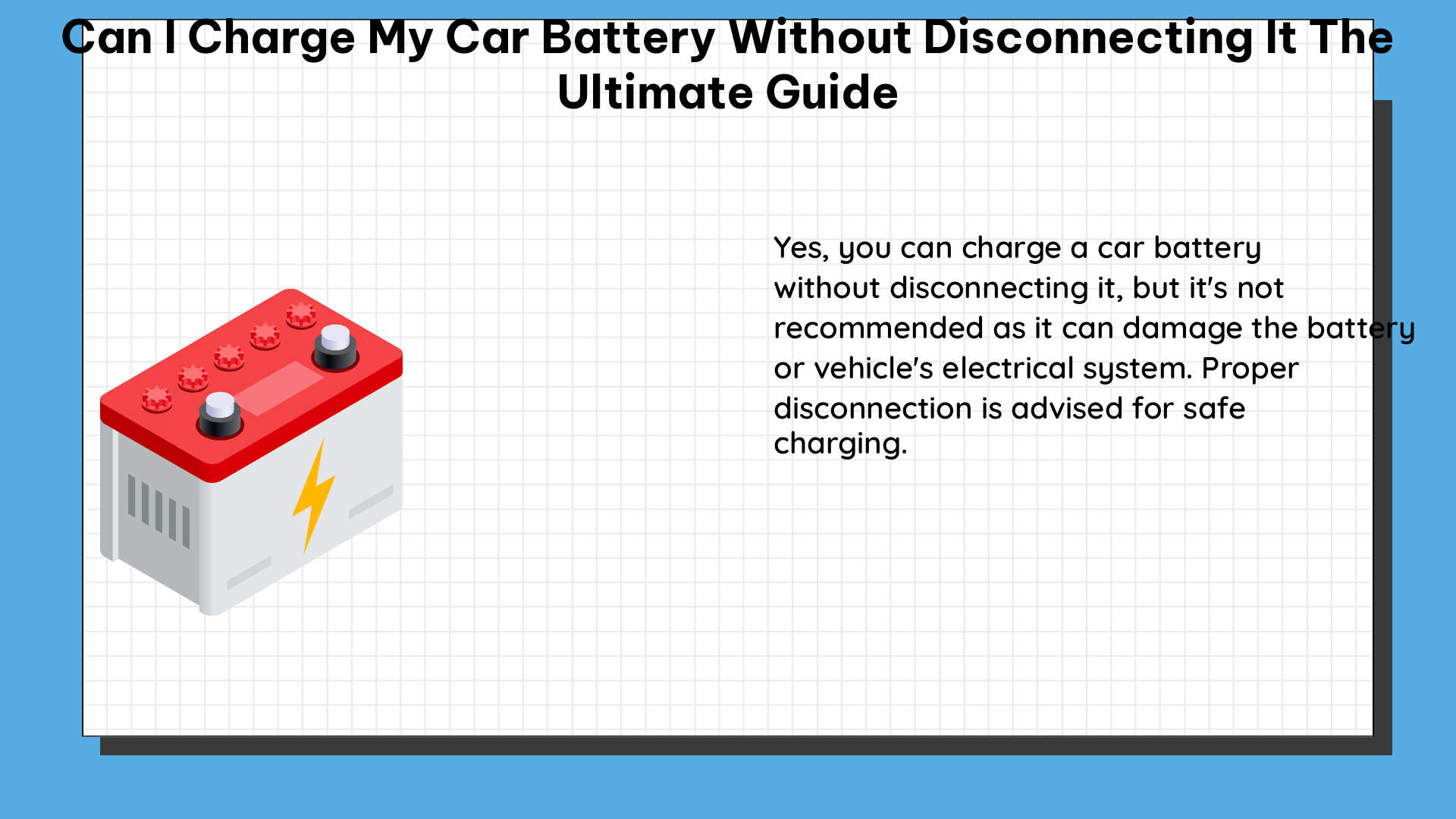Charging a car battery without disconnecting it is a convenient and efficient way to maintain your vehicle’s electrical system, but it requires careful consideration of various factors to ensure the process is carried out safely and effectively. This comprehensive guide will provide you with the technical details and step-by-step instructions to charge your car battery without disconnecting it, helping you keep your vehicle’s power source in top condition.
Understanding the Charging Process
When charging a car battery without disconnecting it, the key is to use a smart or trickle charger that is specifically designed for this purpose. These chargers are equipped with advanced features that allow them to safely charge the battery while it is still connected to the vehicle’s electrical system.
Charger Types and Charging Modes
The two main types of chargers suitable for charging a car battery without disconnecting it are:
-
Smart Chargers: These chargers have multiple charging modes, including constant current, constant voltage, and float charge. The float charge mode is particularly useful for maintaining the battery’s charge level without overcharging it.
-
Trickle Chargers: Also known as maintenance chargers, these chargers are designed to slowly and gently charge the battery, preventing overcharging and damage to the vehicle’s electrical components.
It’s important to avoid using fast chargers or high-powered chargers, as they may supply a higher voltage that could potentially damage the vehicle’s electrical system.
Battery Condition Considerations
The battery’s condition is a crucial factor when charging it without disconnecting it. If the battery is heavily discharged or damaged, it may not be able to handle the charging process without being disconnected. In such cases, it’s recommended to have the battery tested and replaced if necessary.
Preparing for the Charging Process

Before you begin charging your car battery without disconnecting it, there are a few steps you should take to ensure a safe and successful process:
-
Locate the Battery: Identify the location of the battery in your vehicle, as this will be necessary for connecting the charger.
-
Clean the Battery Terminals: Use a wire brush or battery terminal cleaner to remove any corrosion or buildup on the battery terminals. This will ensure a good electrical connection for the charging process.
-
Ensure Proper Ventilation: Make sure the charging area is well-ventilated, as the charging process can release hydrogen gas, which is flammable.
-
Gather the Necessary Equipment: Assemble the smart or trickle charger, as well as any necessary tools or accessories, such as battery clamps or a voltmeter.
Connecting the Charger
Once you have prepared the area and gathered the necessary equipment, follow these steps to connect the charger to your car battery without disconnecting it:
-
Identify the Positive and Negative Terminals: Locate the positive (red) and negative (black) battery terminals in your vehicle.
-
Connect the Charger Clamps: Attach the positive (red) clamp of the charger to the positive battery terminal, and the negative (black) clamp to a metal ground or the negative battery terminal.
-
Plug in the Charger: Plug the charger into a suitable power outlet and turn it on.
-
Monitor the Charging Process: Keep an eye on the charger’s display or indicators to ensure the charging process is progressing as expected. Refer to the charger’s instructions for specific guidance on monitoring the charging process.
Charging Time and Considerations
The charging time for your car battery without disconnecting it will depend on several factors, including:
- Battery Capacity: The battery’s capacity, measured in ampere-hours (Ah), will determine the amount of time required for a full charge.
- Charger Specifications: The charging current and voltage output of the charger will also affect the charging time.
- Battery Condition: If the battery is heavily discharged or damaged, it may take longer to charge.
As a general guideline, a 46Ah battery charged with a 10A smart charger may take approximately 4-6 hours to reach a full charge, depending on the battery’s initial state of charge.
It’s important to monitor the charging process and avoid overcharging the battery, as this can damage the vehicle’s electrical system. Once the battery is fully charged, disconnect the charger and ensure the battery terminals are secure.
Troubleshooting and Safety Considerations
If you encounter any issues during the charging process or have concerns about the safety of charging your car battery without disconnecting it, consider the following:
- Battery Condition: If the battery is heavily discharged or damaged, it may not be able to handle the charging process without being disconnected. In such cases, have the battery tested and replaced if necessary.
- Electrical System Compatibility: Ensure the charger you are using is compatible with your vehicle’s electrical system. Refer to the manufacturer’s instructions or consult a professional if you are unsure.
- Overcharging Concerns: Be vigilant for signs of overcharging, such as excessive heat or bubbling from the battery. If this occurs, disconnect the charger immediately.
- Ventilation and Safety: Maintain proper ventilation and keep the charging area free from any potential ignition sources, as the charging process can release flammable hydrogen gas.
By following the guidelines and safety precautions outlined in this comprehensive guide, you can confidently charge your car battery without disconnecting it, ensuring your vehicle’s electrical system remains in optimal condition.
References:
- Charging Car Battery with Charger Without Disconnecting from Car
- Can You Charge 12V Battery Without Disconnecting?
- Battery Charging on the Vehicle Without Disconnecting Terminals

The lambdageeks.com Core SME Team is a group of experienced subject matter experts from diverse scientific and technical fields including Physics, Chemistry, Technology,Electronics & Electrical Engineering, Automotive, Mechanical Engineering. Our team collaborates to create high-quality, well-researched articles on a wide range of science and technology topics for the lambdageeks.com website.
All Our Senior SME are having more than 7 Years of experience in the respective fields . They are either Working Industry Professionals or assocaited With different Universities. Refer Our Authors Page to get to know About our Core SMEs.